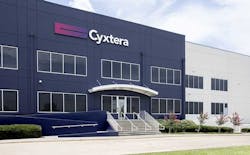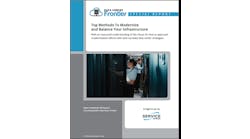Cyxtera Technologies is now a public company. Shares of Cyxtera trading on the NASDAQ exchange this morning after Starboard Value Acquisition Corp. completed its $3 billion acquisition of the company.
To mark the transition, Starboard Value Acquisition today changed its name to Cyxtera Technologies, and changed it stock symbol from SVAC to CYXT. In early action on the NASDAQ exchange, shares of CYXT were trading at $9.68 per share, up about 1 percent.
Cyxtera received $493 million in cash from the transaction, which will be used to pay down debt and invest in growth. The transaction and public listing provide Cyxtera with a deeper pool of capital to compete in the global market for colocation and interconnection services. The Cyxtera team sees a business opportunity in making these services easier to consume, as well as the potential for both organic growth and acquisitions.
“Today marks a key milestone in a journey we launched in 2017 to build a global leader in digital infrastructure,” said Manuel D. Medina, Chair of Cyxtera and Founder and Managing Partner of Medina Capital. “Cyxtera already has a strong track record of value creation, and we look forward to continuing to deliver innovative solutions for our customers across our global data center platform.”
“This is an exciting day,” said Nelson Fonseca, the CEO of Cyxtera. “We’ve always wanted to be public, and it’s been a long time coming.”
Cyxtera provides another option for public investors to participate in the growth of the data center sector. There are now 8 publicly-held data center developers in the U.S., including Equinix, Digital Realty, CyrusOne, CoreSite, Digital Bridge, Switch, Iron Mountain and QTS Realty, which will soon go private through a $10 billion acquisition by Blackstone.
The world’s largest investors are focusing on the market for digital infrastructure, citing extraordinary demand for capital to fuel the data economy. This includes active funding and M&A through private channels, but the data center sector has also been a winner for most investors in the public markets as well.
Starboard is a SPAC (special purpose acquisition corporation) that already went public and is listed on the NASDAQ. A SPAC is an investment vehicle that goes public and raises capital from investors for the purpose of acquiring a private company. Some analysts see selling to SPACs as a faster and more efficient path to the public markets than a traditional IPO.
Innovating to Make Services Easier to Consume
That’s the case for Cyxtera, which operates 61 data centers spanning 1.9 million square feet in 29 markets around the world and more than 2,300 enterprise customers. Cyxtera Technologies was formed in 2016 when Medina Capital – led by former Terremark CEO Medina – teamed with investors including BC Partners to buy the data center portfolio of CenturyLink for $2.15 billion. It was one of several data center players seeking to build a colocation business atop a portfolio of data centers spun off by telecom companies. These “carve outs” can be challenging, and take some time to complete.
“There are several things we needed to accomplish before becoming public,” said Fonseca. “We needed to fully complete the carve out, and we wanted real momentum in our business. Having completed our merger with SVAC, we now can accelerate our plans to drive high-margin growth through increased utilization of our existing assets, development of innovative product offerings, and expansion of our global footprint.”
Nelson Fonseca, the CEO of Cyxtera Technologies.
A stronger capital position enables Cyxtera to grow and fund innovation, which Fonseca sees as a strategic priority.
“Our innovation is really focused on making the data center easier to consume,” said Fonseca. “This is an area where we really take a leadership role in the industry. We have 2,300 customers and they’re large enterprises, and they want to connect to one another.”
A key enabler for interconnection will be the Digital Exchange platform, also known as CXD or Cyxtera eXtensible Data Center. It’s a network fabric and provisioning engine for Cyxtera’s Digital Exchange offering, which provides users with a single physical port with multiple virtual connections that can be managed through APIs. Cyxtera also offer enterprise bare metal servers provided “on demand” as part of larger version to provide customers with APIs and software-managed interfaces.
“We’ve been working on this for over two years, and now we’re starting to hear a lot of similar approaches from other folks in the industry,” said Fonseca. “Other folks may call that cloudification. We make those interconnections easier to consume and facilitate what we call ‘East-West connections,’ a term you’re hearing more and more about in the industry now.”
Cyxtera currently has 40,000 cross-connects, and interconnection accounts for about 10 percent of revenue, Fonseca said.
Roadmap for Both Organic Growth and Acquisitions
Another key top growth will be filling Cyxtera’s data centers, which are currently at 70 percent of capacity. Boosting utilization to 85 percent would bring in an additional $170 million a year in EBITDA. Fonseca says core bookings are strong, and up about 45 percent from this time last year.
Fonseca is bullish on future growth for customers adopting artificial intelligence (AI) in their IT operations, including demand from the federal government.
“I think AI applications cross every vertical,” he said. “AI provides so many benefits, but the hardware is expensive. AI is going to be a growth industry, but it’s not simple. Over time, the provider who figures it out is going to be a big winner in the AI marketplace.”
After several years of consolidation, Fonseca says the data center industry remains fragmented, and acquisitions will be part of Cyxtera’s growth strategy.
“We will look at inorganic opportunities,” he said. ” You will see us be more aggressive in international markets. We have the ability to roll up other platforms. We’re in a privileged position, in that we don’t have to do any acquisitions and inorganic growth. But we might.”






